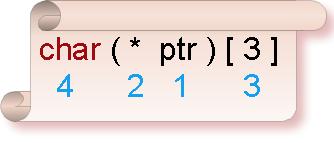Rule 1. Assign the priority to the pointer declaration considering precedence and associative according to following table.
(): This operator behaves as bracket operator or function operator.
[]: This operator behaves as array subscription operator.
*: This operator behaves as pointer operator not as multiplication operator.
Identifier:
It is not an operator but it is name of pointer variable. You will
always find the first priority will be assigned to the name of pointer.
Data type: It is also not an operator. Data types also includes modifier (like signed int, long double etc.)
You will understand it better by examples:
(1) How to read following pointer?
char (* ptr)[3]
Answer:
Step 1:
() and [] enjoys equal precedence. So rule of associative will decide
the priority. Its associative is left to right So first priority goes to
().

Step 2:
Inside the bracket * and ptr enjoy equal precedence. From rule of
associative (right to left) first priority goes to ptr and second
priority goes to *.

Step3: Assign third priority to [].

Step4: Since data type enjoys least priority so assign fourth priority to char.

Now read it following manner:
ptr is pointer to such one dimensional array of size three which content char type data.
(2) How to read following pointer?
float (* ptr)(int)
Answer:
Assign the priority considering precedence and associative.

Now read it following manner:
ptr is pointer to such function whose parameter is int type data and return type is float type data.
Rule 2: Assign the priority of each function parameter separately and read it also separately.
Understand it through following example.
(3) How to read following pointer?
void (*ptr)(int (*)[2],int (*) void))
Answer:
Assign the priority considering rule of precedence and associative.

Now read it following manner:
ptr is pointer to such function which first parameter is pointer to one dimensional array of size two which content int type data and second parameter is pointer to such function which parameter is void and return type is int data type and return type is void.
(4) How to read following pointer?
int ( * ( * ptr ) [ 5 ] ) ( )
Answer:
Assign the priority considering rule of precedence and associative.

Now read it following manner:
ptr is pointer to such array of size five which content are pointer to such function which parameter is void and return type is int type data.
(5) How to read following pointer?
double*(*(*ptr)(int))(double **,char c)
Answer:

Assign the priority considering rule of precedence and associative.
Now read it following manner:
ptr is pointer to function which parameter is int type data and return type is pointer to function which first parameter is pointer to pointer of double data type and second parameter is char type data type and return type is pointer to double data type.
(6) How to read following pointer?
unsigned **(*(*ptr)[8](char const *, ...)
Answer:
Assign the priority considering rule of precedence and associative.

Now read it following manner:

0 comments:
Post a Comment